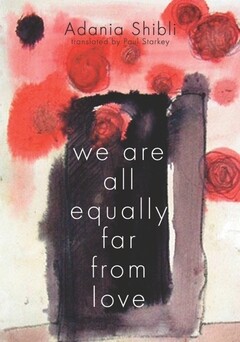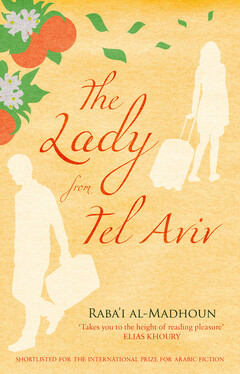The Electronic Intifada 30 April 2010

The book is referred to as a novel or novella, which is almost a disservice to this unusual, mesmerizing work. A “novel” gives the false promise of a familiar, even predictable read — because no matter how risky or even genius the writing is, all those words are usually laid upon the solid backbone of a plot, maybe, or on the steady and satisfying transformation of a protagonist having experiences.
But from the very first page it is evident that Touch will be a different sort of journey, one that cannot be immediately defined, if at all. A little girl who is not named stands beside a water tank. She picks at rust. The rust turns to gold in the sunlight. All is silent. She pees down her legs. Turn the page. The girl now rides on bales of hay stacked on a pickup truck. A rainbow appears. This is not a novel, you think. This is something else.
Whatever it is — a dream, memory fragments, poems folded into sun and grass — Touch is both remarkable and difficult, beautifully lucid and yet also mysterious. The book is divided into sections entitled “Colors,” “Silence,” “Movement,” “Language” and “The Wall,” which, except for the last, are themselves divided into numbered subsections. Within this framework the little girl comes of age, her ordinary experiences of first love, school mishaps and sibling rivalries rendered extraordinary by the sensuous prose, and intensified by the heartbreaking backdrop against which they occur, a death whose impact tears apart the fabric of her family’s life.
The narrative moves back and forth in time and from place to place, this central tragedy woven through in fragments, never fully visible, rendered all the more poignant by being illuminated through stories and scenes that seem unrelated, and are themselves obscure, at first.
Early in the book, we read: “Waves of sound moved toward the little girl, each trying to be the first to reach her ears and fall on them like a hammer pounding, and her ears opened wide to welcome them. After her brother’s scream, she heard the fly, and after it flew away, she heard the hum of the electric meter. / In the entire world there was not a single moment of silence. / The sounds that stormed her ears would not come out. They piled on top of each other” (16).
The reader is well into the book, or on the second reading, before this passage begins to yield its deeper possible meanings. It is Shibli’s language that keeps us captivated and willing to tolerate the mysteriousness that pervades the girl’s stories. The words and phrases are like threads stitching us to the fragmented narrative, compelling us to read on in order to understand what, exactly, lies at the heart. Reading this book, strangely, feels like remembering — for what is memory but a collection of blinding, vivid sensations so real you close your eyes and inhabit them completely, mingled with impressions so vague they might not have any substance at all, and beneath all this, the mass of truths that remain submerged, either because they are of no consequence, or of consequence so devastating they cannot be faced.
To discuss the events of this narrative in any detail would be to diminish the reader’s experience — understanding arrives a little at a time, shaped by the girl’s focus on color, or silence, or movement. It emerges, retreats, reappears as if being lifted slowly through dark water until just touched by streams of light, and there it stays, still imperfect, and yet accompanied by acute emotion that stays long after the last page is turned.
That the reader has such a subtle and powerfully emotional experience is testament to Shibli’s skill, born as it is of language that on one level is deliberately distancing. We never quite forget that we are reading, as the characters remain archetypal: the girl, the mother, the father, and so on. Meanwhile, the setting, for the most part, could be anywhere, like a fairy tale. But unlike a fairy tale, this girl and mother and father and all the rest become excruciatingly real, because they are not archetypes of roles, but of emotion, of thought and experience, expressed through the purity of a child’s gaze.
This marriage between archetype and emotion is typified by the following examples, plucked randomly from pages overflowing with such riveting language:
“On the way back, the mother moved her mouth angrily without stopping, while the father gripped the steering wheel without moving it or his lips much. Silence hung on the stillness of the father’s lips, and on the silence hung the little girl’s eyes” (17), and:
“The mother’s grief and prayer mixed together; she wept when she was praying and when she wept, bits of prayers spilled out, as though the tears had erased some of the letters or words, as rain had once erased the girl’s dictation notebook” (61).
And also unlike in a fairy tale, the details of the setting — the sound of rain on a roof, the veranda railing, the mother’s bracelets jingling down her arm, the white wall — take on shades of meaning so complex that they can only be fathomed through reading again, and again, and again.
A reader who enters this book by a Palestinian author expecting it to explore history, identity and occupation will be disarmed as swiftly as the reader who expected a novel. Touch is unconcerned with the larger scope of history, only the little girl’s delicate, shimmering experience of her immediate world. When the girl hears the phrase “Sabra and Shatila,” at first she cannot comprehend, then she becomes entranced by the cactus, near her school, and then she performs an action that forever ostracizes her from her classmates.
The phrase “Sabra and Shatila” is altered in meaning, becoming yet another signifier for the little girl’s immense loneliness and sorrow. Perhaps in the same way, the disjointed, dreamy, at times bewildering tales of young, sweet love, verandas and cars and roads, brutal sibling rivalries, suicide, summer fields and rainstorms, are themselves signifiers pointing to the central truths that drive the girl into a solitary, silent existence.
In one of the last sections of the book, the little girl takes to reading her family’s private writings: “Shared events and similar feelings gathered in every diary and on every sheet of paper, transforming the single world of the house into several distinct, contradictory worlds, which the girl’s eyes traversed. She read all the pages and reread them again and again” (66).
The reader of Touch without doubt should do the same, and will desire to do so. This is not a book to be shelved once finished. It calls to you softly, insistently, until you pick it up again and allow yourself to be tugged back in, seeking truth. The Russian writer Anton Chekhov famously said a story should not answer questions but pose them, and perhaps this is what Touch can be called, a question, rather than a novel — that place from where all searches begin.
Patricia Sarrafian Ward is a writer and book artist. Her novel The Bullet Collection was published by Graywolf Press in 2003, and her stories and poems have appeared in numerous literary journals.
Related Links



